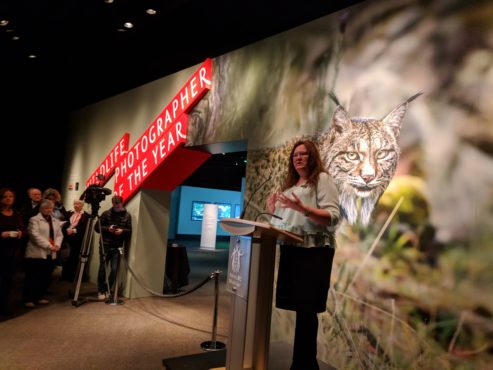
The Wildlife Photography of the Year launch. Photo by Angel Manguerra, Staff Writer
Royal BC Museum event serves breathtaking visuals and important message
You walk into the Royal BC Museum and are greeted by magnificent shots of canyons, arctic foxes, and tiger sharks. Welcome to the Wildlife Photographer of the Year exhibit.
The world-renowned competition and showcase is run by the Natural History Museum in London and has been in operation since 1965. In 2017, over 150 000 people in London alone viewed the 100-photo exhibit, complete with thoughtful captions and technical information describing how each shot was taken.
Currently in its 53rd year, the contest has grown to be one of the highest honours a wildlife photographer can receive. Boasting approximately 1 billion annual viewers, an image displayed at the exhibit can be career changing.
—————
“I think some people see nature as completely separate from their lives when actually we’re all part of it.”
—————
A facet of the competition that has held more and more weight over the years relates to the role wildlife photography plays in animal conservation. This year’s winner, Brent Stirton, told National Geographic that the competition is how “[the photo] gets another life, or it gets seen by that many more people, [so] the issue gets a certain longevity.” His winning photo of a dead black rhino with his horn freshly sawed off by poachers is haunting and regal: a true testament to the species who are being decimated for their horns.
One of this year’s panellist judges, Roz Kidman Cox, said much the same of Stirton’s image. “There is a rawness, but there is also great poignancy and therefore dignity in the fallen giant,” Cox said in a press release. “It’s also symbolic of one of the most wasteful, cruel and unnecessary environmental crimes, one that needs to provoke the greatest public outcry.”
Environmental outreach and education is a large part of why this competition stays so relevant. Wildlife photographer Michel d’Oultremont, winner of the 2017 “Rising Star” award for Wildlife Photographer of the Year, speaks in his short film “The Wait” about the value of recognizing that we are all a part of the environment.
“I think some people see nature as completely separate from their lives when actually we’re all part of it.”
This year’s exhibit does not disappoint. I highly recommend carving out a couple hours to peruse the magnificent example of what our natural world has to offer before the exhibit closes on April 2. The patience and connection to nature that these talented photographers possess will no doubt inspire thoughts of travelling the world and focussing on conserving the beautiful nature it possesses. It may be one of the best ways to spend a rainy Sunday afternoon.








